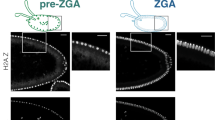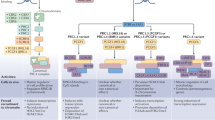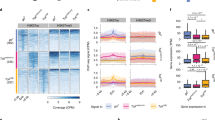Abstract
Polycomb group (PcG) proteins maintain transcriptional repression of developmentally important genes1 and have been implicated in cell proliferation and stem cell self-renewal2. We used a genome-wide approach3 to map binding patterns of PcG proteins (Pc, esc and Sce) in Drosophila melanogaster Kc cells. We found that Pc associates with large genomic regions of up to ∼150 kb in size, hereafter referred to as 'Pc domains'. Sce and esc accompany Pc in most of these domains. PcG-bound chromatin is trimethylated at histone H3 Lys27 and is generally transcriptionally silent. Furthermore, PcG proteins preferentially bind to developmental genes. Many of these encode transcriptional regulators and key components of signal transduction pathways, including Wingless, Hedgehog, Notch and Delta. We also identify several new putative functions of PcG proteins, such as in steroid hormone biosynthesis. These results highlight the extensive involvement of PcG proteins in the coordination of development through the formation of large repressive chromatin domains.
This is a preview of subscription content, access via your institution
Access options
Subscribe to this journal
Receive 12 print issues and online access
$209.00 per year
only $17.42 per issue
Buy this article
- Purchase on Springer Link
- Instant access to full article PDF
Prices may be subject to local taxes which are calculated during checkout






Similar content being viewed by others
References
Ringrose, L. & Paro, R. Epigenetic regulation of cellular memory by the Polycomb and Trithorax group proteins. Annu. Rev. Genet. 38, 413–443 (2004).
Valk-Lingbeek, M.E., Bruggeman, S.W. & van Lohuizen, M. Stem cells and cancer; the polycomb connection. Cell 118, 409–418 (2004).
van Steensel, B., Delrow, J. & Henikoff, S. Chromatin profiling using targeted DNA adenine methyltransferase. Nat. Genet. 27, 304–308 (2001).
van Steensel, B. & Henikoff, S. Identification of in vivo DNA targets of chromatin proteins using tethered dam methyltransferase. Nat. Biotechnol. 18, 424–428 (2000).
Sun, L.V. et al. Protein-DNA interaction mapping using genomic tiling path microarrays in Drosophila. Proc. Natl. Acad. Sci. USA 100, 9428–9433 (2003).
Nègre, N. et al. Chromosomal distribution of PcG proteins during Drosophila development. PLoS Biol. 4, e170 (2006).
Ringrose, L., Rehmsmeier, M., Dura, J.M. & Paro, R. Genome-wide prediction of Polycomb/Trithorax response elements in Drosophila melanogaster. Dev. Cell 5, 759–771 (2003).
Dejardin, J. et al. Recruitment of Drosophila Polycomb group proteins to chromatin by DSP1. Nature 434, 533–538 (2005).
Greil, F. et al. Distinct HP1 and Su(var)3–9 complexes bind to sets of developmentally coexpressed genes depending on chromosomal location. Genes Dev. 17, 2825–2838 (2003).
Schubeler, D. et al. Genome-wide DNA replication profile for Drosophila melanogaster: a link between transcription and replication timing. Nat. Genet. 32, 438–442 (2002).
Schubeler, D. et al. The histone modification pattern of active genes revealed through genome-wide chromatin analysis of a higher eukaryote. Genes Dev. 18, 1263–1271 (2004).
Breiling, A., O'Neill, L.P., D'Eliseo, D., Turner, B.M. & Orlando, V. Epigenome changes in active and inactive polycomb-group-controlled regions. EMBO Rep. 5, 976–982 (2004).
Stolc, V. et al. A gene expression map for the euchromatic genome of Drosophila melanogaster. Science 306, 655–660 (2004).
Ficz, G., Heintzmann, R. & Arndt-Jovin, D.J. Polycomb group protein complexes exchange rapidly in living Drosophila. Development 132, 3963–3976 (2005).
Hernandez-Munoz, I., Taghavi, P., Kuijl, C., Neefjes, J. & vanLohuizen, M. Assocation of BMI1 with Polycomb bodies is dynamic and requires PRC2/EZH2 and the maintenance DNA methyltransferase DNMT1. Mol. Cell. Biol. 25, 11047–11058 (2005).
Harris, M.A. et al. The Gene Ontology (GO) database and informatics resource. Nucleic Acids Res. 32, D258–D261 (2004).
Lascaris, R. et al. Hap4p overexpression in glucose-grown Saccharomyces cerevisiae induces cells to enter a novel metabolic state. Genome Biol. 4, R3 (2003).
Kirmizis, A., Bartley, S.M. & Farnham, P.J. Identification of the polycomb group protein SU(Z)12 as a potential molecular target for human cancer therapy. Mol. Cancer Ther. 2, 113–121 (2003).
Klebes, A. et al. Regulation of cellular plasticity in Drosophila imaginal disc cells by the Polycomb group, trithorax group and lama genes. Development 132, 3753–3765 (2005).
Leung, C. et al. Bmi1 is essential for cerebellar development and is overexpressed in human medulloblastomas. Nature 428, 337–341 (2004).
Maurange, C. & Paro, R. A cellular memory module conveys epigenetic inheritance of hedgehog expression during Drosophila wing imaginal disc development. Genes Dev. 16, 2672–2683 (2002).
Paul, S.M., Ternet, M., Salvaterra, P.M. & Beitel, G.J. The Na+/K+ ATPase is required for septate junction function and epithelial tube-size control in the Drosophila tracheal system. Development 130, 4963–4974 (2003).
Warren, J.T. et al. Molecular and biochemical characterization of two P450 enzymes in the ecdysteroidogenic pathway of Drosophila melanogaster. Proc. Natl. Acad. Sci. USA 99, 11043–11048 (2002).
Baehrecke, E.H. Steroid regulation of programmed cell death during Drosophila development. Cell Death Differ. 7, 1057–1062 (2000).
Henikoff, S., Ahmad, K., Platero, J.S. & van Steensel, B. Heterochromatic deposition of centromeric histone H3-like proteins. Proc. Natl. Acad. Sci. USA 97, 716–721 (2000).
Cleveland, W.S. Robust locally weighted regression and smoothing scatterplots. J. Am. Stat. Assoc. 74, 829–836 (1979).
van Steensel, B., Delrow, J. & Bussemaker, H.J. Genomewide analysis of Drosophila GAGA factor target genes reveals context-dependent DNA binding. Proc. Natl. Acad. Sci. USA 100, 2580–2585 (2003).
Baldi, P. & Long, A.D. A Bayesian framework for the analysis of microarray expression data: regularized t-test and statistical inferences of gene changes. Bioinformatics 17, 509–519 (2001).
Benjamini, Y. & Hochberg, Y. Controlling the false discovery rate: a practical and powerful approach to multiple testing. J. R. Stat. Soc. Ser. B Methodolog. 57, 289–300 (1995).
Rietveld, L.E., Caldenhoven, E. & Stunnenberg, H.G. In vivo repression of an erythroid-specific gene by distinct corepressor complexes. EMBO J. 21, 1389–1397 (2002).
Acknowledgements
We thank G. Cavalli and N. Nègre for sharing unpublished results and for providing Pc and ph antibodies; J. Müller for Su(z)12 antibody; F. Greil, H. Pickersgill, M. Heimerickx and the NKI Central Microarray Facility for technical assistance; M. Fornerod for sharing R scripts; H. Bussemaker for the Quontology script; the Genomics Facility of the Fred Hutchinson Cancer Research Center for preparing 12K cDNAs and A. Brinkman and H. Stunnenberg for help with ChIP. This work was supported by a Veni fellowship from the Netherlands Organisation for Scientific Research (NWO) to B.T., a fellowship from the Association of International Cancer Research to I.M., a Centre for Biomedical Genetics grant to M.v.L. and support from the European 'Epigenome' Network of Excellence and a European Young Investigator (EURYI) award to B.v.S.
Author information
Authors and Affiliations
Corresponding authors
Ethics declarations
Competing interests
The authors declare no competing financial interests.
Supplementary information
Supplementary Fig. 1
PcG-Dam fusions incorporate into native PRCs. (PDF 60 kb)
Supplementary Fig. 2
Overview of all identified Pc domains. (PDF 1352 kb)
Supplementary Fig. 3
Pc, GAF and HP1 binding on the Adh-cactus region. (PDF 76 kb)
Supplementary Fig. 4
Correspondence between Pc binding analyzed on two microarray platforms. (PDF 89 kb)
Supplementary Fig. 5
Nuclear localization of endogenous Pc and HP1 proteins. (PDF 43 kb)
Supplementary Table 1
Binding ratios of reported PcG target genes. (PDF 30 kb)
Supplementary Table 2
Pc domains identified using genomic tiling arrays. (PDF 40 kb)
Supplementary Table 3
Quontology data PcG protein binding profiles. (XLS 255 kb)
Supplementary Table 4
Pc targets for each GO category enriched for Pc binding. (XLS 100 kb)
Supplementary Table 5
Pc targets in 'Ectoderm development' GO category. (PDF 49 kb)
Supplementary Table 6
Gene ontology on genes identified in Pc domains. (XLS 164 kb)
Rights and permissions
About this article
Cite this article
Tolhuis, B., Muijrers, I., de Wit, E. et al. Genome-wide profiling of PRC1 and PRC2 Polycomb chromatin binding in Drosophila melanogaster. Nat Genet 38, 694–699 (2006). https://doi.org/10.1038/ng1792
Received:
Accepted:
Published:
Issue Date:
DOI: https://doi.org/10.1038/ng1792
This article is cited by
-
Functional dissection of PRC1 subunits RYBP and YAF2 during neural differentiation of embryonic stem cells
Nature Communications (2023)
-
Context-specific Polycomb mechanisms in development
Nature Reviews Genetics (2022)
-
PRC2: an epigenetic multiprotein complex with a key role in the development of rhabdomyosarcoma carcinogenesis
Clinical Epigenetics (2021)
-
The molecular principles of gene regulation by Polycomb repressive complexes
Nature Reviews Molecular Cell Biology (2021)
-
Broad genic repression domains signify enhanced silencing of oncogenes
Nature Communications (2020)



